- Wayland Vaughan, Secretary of the National Society of Fine Arts, meets with artist and writer Francis D. Millet and art historian Florence N. Levy to discuss the need for a national body to advance the cause of art in America. The group continues to meet sporadically over the next 3 years. The idea wins the support of President Theodore Roosevelt, who entrusts the project to his close advisor, Secretary Elihu Root.
1906
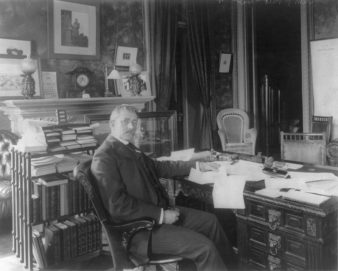
1909
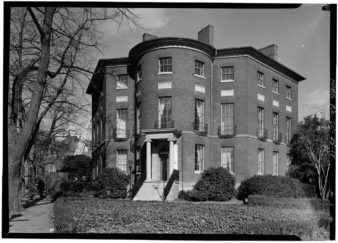
- In response to a request from Fort Worth’s Carnegie Public Library, AFA sends out its first traveling exhibition: 38 Oil Paintings by Prominent American Artists. Viewed by more than 5,600 visitors at the library, the exhibition then travels to New Orleans, St. Paul, and New Ulm, Minnesota. Two other exhibitions are circulated in the 1909-10 seasons: 30 Watercolors and 35 Photographs of Famous Monuments and Other Works of Art.
- To meet the needs of institutions unable to secure the services of qualified lecturers, AFA sends out its first illustrated lectures. The subjects are on the fine and applied arts, and each lecture includes a typewritten transcript and 50 black-and-white slides.
- After meeting for several months in Francis Millet’s studio in Washington, D.C., the AFA moves its headquarters into the Octagon Building at 1741 New York Ave., N.W., renting space from the American Institute of Architects.
1910
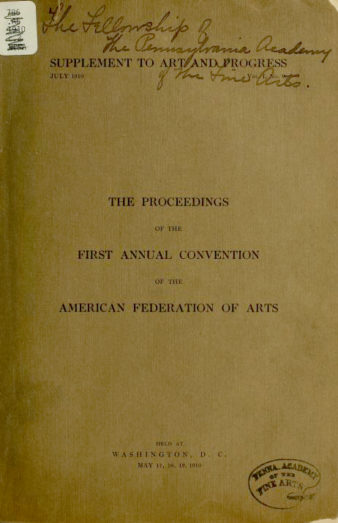
- One year after AFA’s founding, membership numbers 90 institutions and 1,000 individuals from across the country.
- AFA promotes the creation of a National Commission of Fine Arts, which is subsequently established by an act of Congress to advise the government on matters of art and design as they pertain to the nation’s capital.
- AFA’s first annual convention, held in Washington, D.C., draws delegates from nearly 100 art societies, museums, civic associations, schools, and colleges.
1912
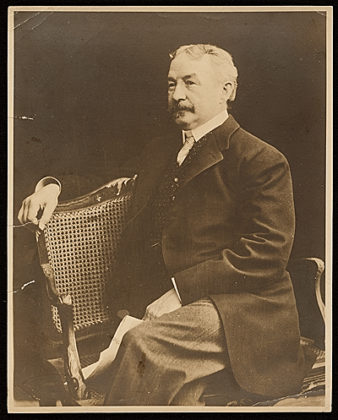
- AFA merges with the National League of Handicraft Societies, and constituent societies are made AFA members.
- AFA takes over publication of the American Art Annual (subsequently renamed the American Art Directory and, in 1952, split into two publications: Who’s Who in American Art and American Art Directory), the standard reference book for art in the US.
- AFA mourns the loss of AFA Board Secretary Francis D. Millet, an AFA founder, who dies in the sinking of the Titanic.
1913
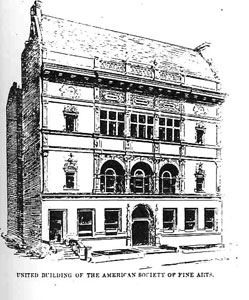
- AFA helps shape government policy with a successful lobbying effort to remove tariffs on art entering the US. The new law allows J.P. Morgan’s extensive art collection to be brought to America from England.
- AFA engages in its first international project, securing US representation in expositions in Rome and Buenos Aires.
- AFA’s first New York office opens in the Fine Arts Building at 215 West 57th The office later moves to the Metropolitan Museum of Art and then to 40 East 49th Street.
1914
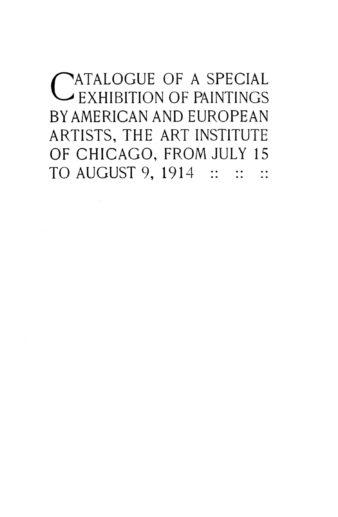
- In the American Art Annual (vol. 11), Editor Florence N. Levy writes, “The result of these (AFA) exhibitions has in many cases been the organization of art associations and the establishment of museums.”
- AFA circulates 23 traveling exhibitions to 114 venues around the country, at fees ranging from $10 to $300 per exhibition. Among the offerings is Exhibition of Paintings by American and European Artists, drawn from the 18th annual exhibition at the Carnegie Institute.
1916
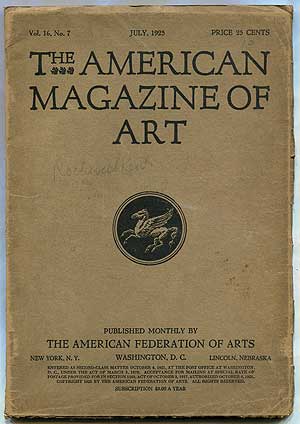
- AFA leaders meet with the Inter-State Commerce Commission to protest prohibitively high interstate taxes on art shipments. These taxes are subsequently reduced.
- With the American Institute of Architects and the American Civic Association, AFA protests the construction of a central heating and power plant on the Potomac River front, adjacent to the park system.
- AFA is incorporated in New York State as a non-profit institution.
- Art and Progress is renamed The American Magazine of Art. Artists Cecilia Beaux, Daniel Chester French, Cass Gilbert and Maxfield Parrish serve as advisory board members.
- AFA’s membership of 223 institutions includes every art museum in the US and one in Canada.
1918
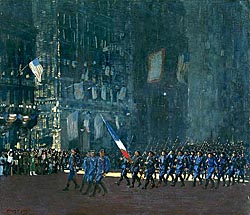
- At the request of the National War Work Commission of the YMCA, AFA produces illustrated, typed lectures on American painting, sculpture, and civic art and French painting and architecture for use in army camps.
- Under the auspices of the AFA, the Division of Pictorial Publicity, and the Mayor’s Committee on National Defense, the Allied War Salon, an exhibition of approximately 800 paintings, sculptures, prints, posters, and drawings by artists of the Allied nations, is presented at the American art Galleries in New York. The selection is made by Duncan Phillips, Albert Eugene Gallatin, and Augustus Vincent Tack, and net proceeds go to the Art War Relief.
1920
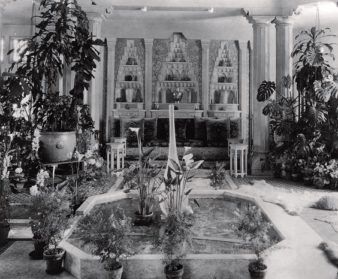
- AFA participates in a lobbying campaign to develop a national gallery, a goal ultimately realized with the founding of the National Gallery of Art in 1941.
To facilitate the placing of exhibitions, AFA opens branch offices at the University of Nebraska (moved in 1930 to Omaha; closed in 1933) and Stanford University (closed in 1927). - AFA’s eleventh annual convention is held at the Metropolitan Museum of Art. On the final day of the convention, a group of AFA delegates and members takes a special train to Laurelton Hall, Louis Comfort Tiffany’s estate in Oyster Bay, where they are greeted by Tiffany.
- AFA inaugurates Pictures for the Home, a program that makes high-quality reproductions of paintings by well-known artists available for purchase “by those desiring to secure good pictures for their homes and as gifts but who are remote from the art centers.” The prices range from 30 cents to 18 dollars each.
1922
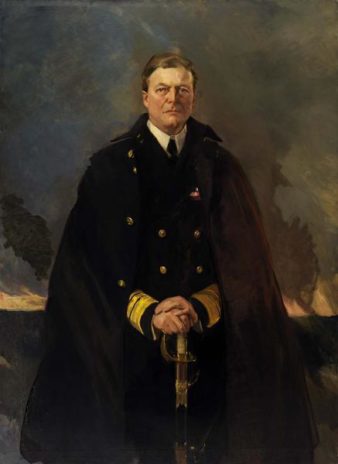
- AFA publishes American Art Sales, a quarterly publication that includes information on the New York, Chicago, and Philadelphia art markets for collectors in remote areas.
- AFA circulates 52 exhibitions in the 1921–22 season, including Paintings Lent by the Metropolitan Museum of Art and War Portraits.
1923
- AFA passes a resolution to campaign against coal smoke in American cities.
- AFA publishes Art in Our Country, a directory of public art in cities and towns across the US.
In order to bring art to people who might not visit exhibitions elsewhere, AFA sends exhibitions to 10 large state fairs. - AFA publicly protests the growth of outdoor advertising. American Magazine of Art Editor and AFA Secretary Leila Mechlin describes billboards as an “intrusion of private interests upon public rights.”
1925
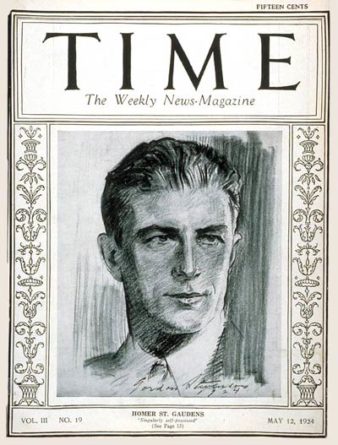
- AFA’s exhibition American Town Planning is shown in Berlin, Vienna, and other European cities.
- AFA launches a series of 15-minute radio talks on art through station WEAF, New York, with a variety of topics and speakers, such as “Getting the Best out of Paintings” by Leigh Hunt and “Making Use of the Museum of Art” by Homer Saint-Gaudens. The talks are so successful that a second series is presented the following year.
1927
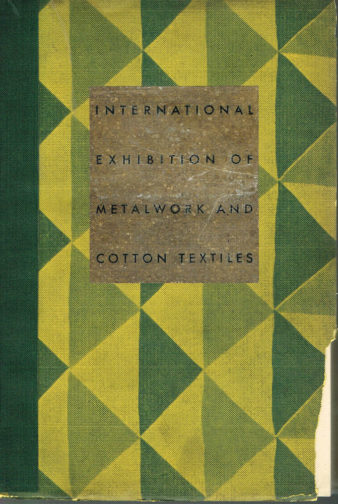
- AFA’s Washington, DC, headquarters—which includes a staff of 18 women and 2 men—moves from the Octagon Building to the Barr Building at 910 17th Street, N.W.
- Arranged in conjunction with the ninth Olympic Games, AFA’s American Sports exhibition is shown in Amsterdam.
- The General Education Board gives AFA $25,000 annually for a period of 3 years to organize a series of exhibitions of contemporary industrial arts. The first exhibition is International Exhibition of Ceramic Art (1927), followed by International Exhibition of Glass and Rugs (1929) and Metalwork and Cotton Textiles—3rd International Exhibition of Contemporary Industrial Art (1930).
1928
- AFA opens a Paris chapter in order to foster cross-cultural exchange.
With a $50,000 grant from the Carnegie Corporation, AFA opens the Little Gallery in Cedar Rapids, Iowa, a 3-year experiment to demonstrate the place of art in community life. - AFA organizes Les graveurs américains contemporains, an exhibition of 300 modern American prints for presentation at the Bibliothèque Nationale in Paris. In exchange, a similar group of French prints tours the U.S.
President Calvin Coolidge addresses a joint meeting of the AFA and the American Association of Museums in Washington, D.C.
1930
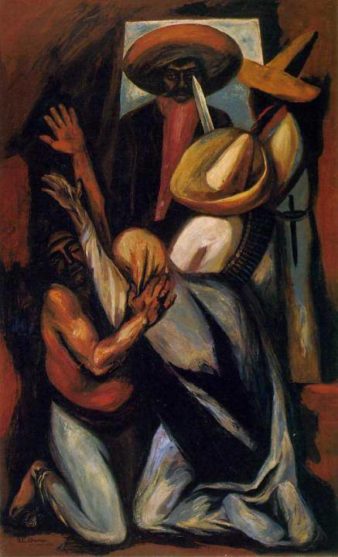
- With a grant from the Carnegie Corporation, AFA organizes the first major exhibition of Mexican art. Including more than 1,200 works of colonial, folk, and modern art selected by René d’Harnoncourt, Mexican Arts opens at The Metropolitan Museum of Art and is subsequently shown at 14 additional venues throughout the U.S.
- AFA sends out 56 exhibitions during the 1930–31 season, with 333 showings in 39 states. Exhibitions include Flower and Still Life Subjects by Well-Known Painters; Hungarian Art; and Wood Block Prints in Color.
1931
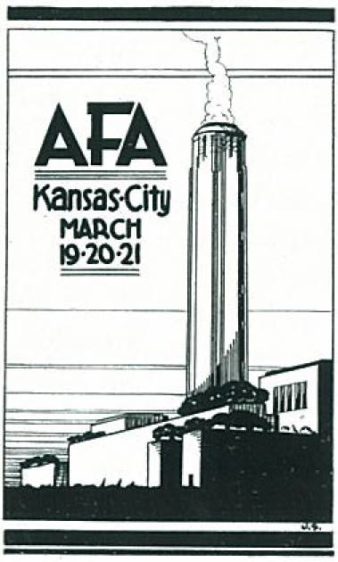
- AFA establishes full-time departments for publications, membership, and art education, as well as an advisory service to act as a clearinghouse for inquiries.
- AFA sends an exhibition of 250 prints to Italy, and in exchange, an exhibition of approximately the same number of works by Italian artists is sent to the US and circulated by AFA.
- With a grant from the Carnegie Corporation, AFA begins a 3-year experiment in elementary art education, providing teachers with lectures, slides, art reproductions, and teaching guides.
At the request of the American-Scandinavian Foundation, AFA organizes an exhibition of American art to be shown in Stockholm and other cities in Europe.
1932
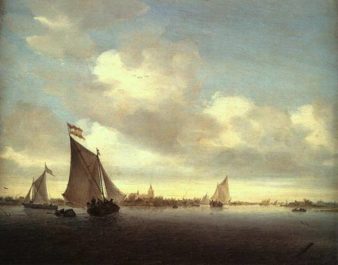
- For the tenth Olympic Games in Los Angeles, AFA organizes Art in Relation to Sports, which is shown at the Los Angeles Museum of History, Science, and Art.
- AFA offers One Picture Exhibitions. Drawn from The Metropolitan Museum of Art’s Department of Paintings, works by artists such as Canaletto, Gainsborough, Inness, Rousseau, Ruysdael, and van Dyck are made available at cost, for 1-to-3-month rentals.
1933
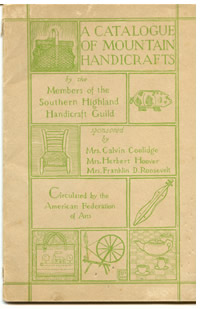
- Among AFA offerings is Originals vs. Reproductions, which includes 10 oil paintings together with their color reproductions and is designed to encourage a more widespread use of color reproductions.
- With Handicrafts of the Southern Highlands, an exhibition of objects made by members of the Southern Highland Handicraft Guild, AFA introduces a wide national audience to the Appalachian craft revival. Almost all the 582 weavings, carvings, baskets, furniture, and quilts in the show are for sale, to be delivered upon completion of the tour.
1934
- In collaboration with the General Federation of Women’s Clubs and with support from the Carnegie Corporation, AFA launches the first nationally broadcast radio series on art, Art in America 1600–1865, with René d’Harnoncourt as program director. The first subject is “Whistler and Winslow Homer, Expatriate and Stay-at-Home.” Discontinued during World War II, the radio program is reestablished in the 1940s with the title “Living Art.”
- At AFA’s twenty-fifth annual convention, held in Washington, D.C., Eleanor Roosevelt gives a talk titled “The New Governmental Interest in the Arts.”
1941
- Among AFA’s exhibition offerings are Contemporary Argentine Art; Housing Here and Abroad—An International Exhibition of Modern Domestic Architecture; The Evolution of the Container; Icelandic Art; and The Prints of Käthe Kollwitz.
- AFA membership includes more than 500 museums, galleries, art schools, and art associations.
1942
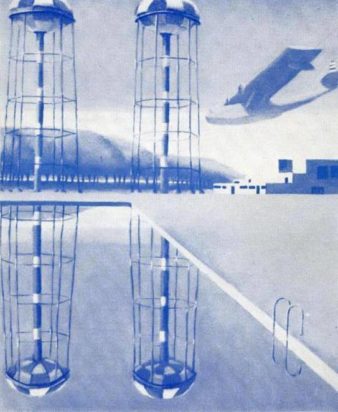
- AFA exhibitions include Creative Art of the American Negro, curated by Holger Cahill and considered at the time the most comprehensive show of its kind ever held in the U.S.; and Art of the Armed Forces, which is drawn from the Life magazine art competition and opens at the National Gallery of Art.
1943
- AFA establishes a National Exhibition Committee of art museum officials, artists, and collectors to review exhibition proposals and make selections.
- AFA cancels its annual convention in order “to aid the government in doing our part in the conservation of civilian travel needed for essential military use.”
1946
- AFA assists in the formation of the Artists Equity Association, organized to further the economic interests of American artists and strengthen their united voice.
- AFA plays a leading role in protesting the U.S. government’s decision to bring more than 200 paintings identified as prewar German acquisitions to the National Gallery for safekeeping. The works are subsequently returned to Germany.
- AFA publishes the Official Directory of American Illustrators and Advertising Artists.
1948
- Since 1909, AFA has circulated 1,921 exhibitions with 9,504 bookings. Exhibitions have gone to every state, Hawaii, Canada, and countries abroad.
- AFA moves from the Barr Building in Washington, D.C., to its own national headquarters building at 1262 New Hampshire Avenue.
With 11 other leading American art organizations, AFA forms the Committee on Government and Art, with the goal of considering governmental involvement in the fine arts and possible methods of enhancing it. - With prices for AFA members ranging from $25 to $250 per exhibition, AFA’s catalogue of traveling exhibitions for the 1948–49 season lists 31 shows, including the first major exhibition of American surrealism, Abstract and Surrealist American Art, which becomes a lightning rod for reactionary criticism.
1949

- AFA begins a 3-year collaboration with The Metropolitan Museum of Art with a series of exhibitions organized by the museum and circulated by the AFA. The Metropolitan Museum Series is designed “to bring the museum to the people” and is intended for museums with budgets of less than $100,000.
- AFA publishes Guide to Films on Art, a pamphlet that sets into motion a wide range of film programs over the following decades.
1950
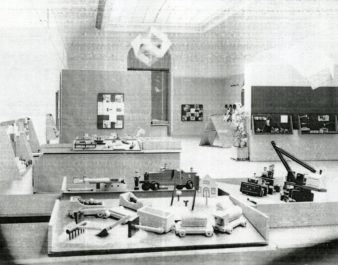
- AFA participates in the U.S. government’s German re-education program, organizing—with a government grant—6 exhibitions for presentation in German museums. Designed “to create a helpful influence on the German people,” the exhibitions include Medieval Indian Sculpture; Form in Handwrought Silver; New Textile Materials; and Educational Toys.
1951
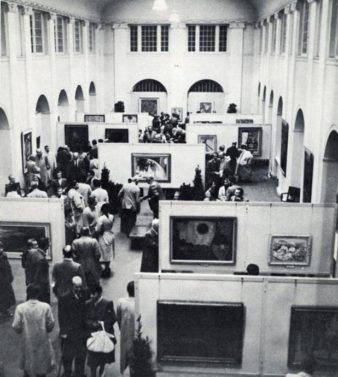
- With the support of the State Department, AFA organizes Contemporary Berlin Artists, an exhibition of 60 paintings and drawings by contemporary German artists for presentation in the U.S. The exhibition arouses such interest that a committee of German museum directors is formed—under the auspices of AFA and the Department of State—to advise on further programs.
- With the Woodstock Artists Association, the College Art Association, Hunter College, and The Metropolitan Museum of Art, AFA co-sponsors the Films on Art Festival, the first art film festival in the U.S. The festival is held in Woodstock, New York; subsequent festivals are held in 1952 and 1957.
- With a grant from the Oberlaender Trust, AFA organizes an exhibition of 65 modern works by American artists for the Berlin Cultural Festival. The following appears in the German newspaper Die Neue Zeitung: “Here they are, at last, genuine American paintings.”
- AFA joins forces with the United States Information Agency (USIA) to create the Overseas Museum Donor Program. Designed to promote American art abroad, the program permits donations of American art to foreign institutions on a restriction-free, tax-deductible basis.
- AFA begins circulating a series of “minishows” for institutions with limited budgets. Minishows consist of 5 to 10 works each and are available for $40 or less. Among the first 6 shows are Marsden Hartley and Five Oils by Walt Kuhn.
- AFA Trustee Eloise Spaeth founds the AFA Newsletter (later called Art Newsletter) to report current art news and inform AFA members about the AFA’s events.
1952
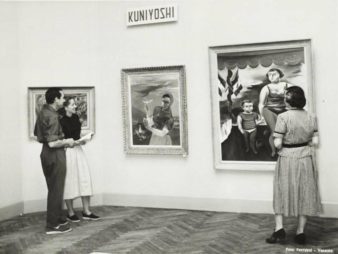
- AFA moves its headquarters from Washington, D.C., to New York, renting offices at 1083 Fifth Avenue.
- At the request of the U.S. Commissioner to the Venice Biennale, AFA selects the art for the U.S. pavilion, the first official U.S. show at the Biennale. The AFA selection committee chooses 4 artists: Alexander Calder, Stuart Davis, Edward Hopper, and Yasuo Kuniyoshi.
With funding from the Spaeth Foundation, AFA publishes Films on Art, a pioneering, comprehensive guide that lists and reviews more than 450 films on art subjects.
1953
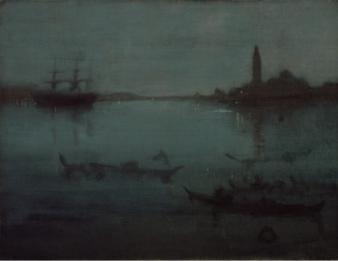
- AFA suspends publication of the Magazine of Art because of financial constraints. The subscription list is transferred to Art News magazine. The committee of German museum directors formed under the auspices of AFA and the State Department asks AFA for a large exhibition of 19th-century American paintings to be shown in Germany. In response, AFA organizes American Painting in the 19th Century, the first survey exhibition of 19th-century American art. Following its presentation in museums in Germany and Italy, the exhibition is shown at the Whitney Museum.
- With a $10,000 grant from the Jean Tennyson Foundation, AFA creates 5 Color-Slide Lectures for circulation to schools, clubs, and art societies. The texts are by H.W. Janson.
- AFA initiates exhibitions that explore aspects of Japanese and German cultural life. The first of these, in 1953, are Postwar German Theater Design; Postwar German Color Prints; and Recent Architecture in Western Germany. Among those that follow are Japan’s Young Dreams (1954) and German Watercolors, Drawings, and Prints, 1905–55 (1956).
- With support from the Ford Foundation and the USIA, AFA organizes an exhibition of American painting to travel to major cities in India.
1954
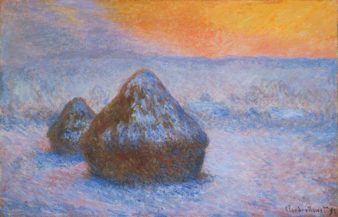
- With a series of 10 exhibitions, AFA begins another collaboration with The Metropolitan Museum of Art, The Metropolitan Museum Series, designed to bring art from the Metropolitan to small institutions and museums.
- With Ford Foundation support, AFA organizes Watercolors for France, an exhibition of 60 contemporary works by 17 American artists, for presentation in La Napoule, Limoges, Castres, Strasbourg, Colmar, and Rennes.
- With a grant from the Carnegie Corporation, AFA inaugurates the Picture-of-the-Month program, offering inexpensive 1-month rentals of important single works of art to museums and art organizations with limited budgets. The program includes works by Gainsborough, Homer, and Monet for as little as $50 per month or $300 for an 8-month subscription.
- At the invitation of the Economic Development Administration of Puerto Rico, AFA Director of Exhibitions (and soon to be Director) Thomas M. Messer surveys conditions on the island preparatory to the founding of an art center in San Juan.
- AFA publishes ABC for Collectors of American Contemporary Art, written by John I.H. Bauer and illustrated by Saul Steinberg.
- AFA’s Board of Trustees unanimously adopts a Statement of Artistic Freedom, which holds that works of art should be judged on their own merit and not on the basis of an artist’s political or social views.
- In an address titled “Perspectives, Horizons” delivered at the 45th annual AFA convention (held at The Metropolitan Museum of Art), poet Wallace Stevens discusses the importance of “the all around man” in the context of the perceived rising tide of specialization in the U.S.
1955
- At the request of the Mainichi Newspapers, AFA organizes an exhibition of watercolors by American artists to travel in Japan as part of Japan’s Third International Art Exhibition. Also organized for presentation abroad are American Cartoons (South America and Europe) and, at the request of the Indian government and with USIA support, American Watercolors, an exhibition of 63 watercolors for presentation in Asia, with showings in New Delhi, Calcutta, Bombay, Madras, Lahore, Peshawar, Karachi, Colombo, Manila, and Tokyo.
- AFA receives a grant of $25,000 from the USIA to “conduct preliminary research and planning, and submit recommendations to the agency, for the preparation of proposed exhibits for circulation abroad.”
- AFA begins circulating Life Magazine Exhibitions, a series of exhibitions drawn from Life magazine photographic material: Egypt; Ancient Maya; The Incas; People of India; The Medieval World; The Holy Land; The Navajos; Emerson’s New England; Sculpture Lesson; and House U.S.A.
1956
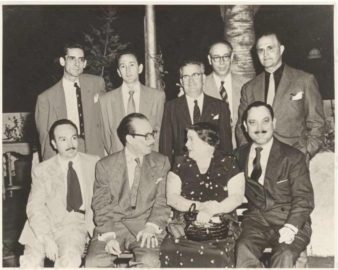
- AFA tours 81 exhibitions to 338 venues.
- AFA founds the Art Collectors Club of America (disbanded in the 1970s) to unite in closer fellowship some of the country’s top collectors. Members meet twice a year for dinner and a talk, followed by a behind-the-scenes museum or collection visit.
- Sponsored by Sports Illlustrated, AFA’s Sport in Art previews at the Dallas Museum of Fine Arts and is then scheduled to travel to Australia during the Olympic Games; but the USIA cancels the international tour due to claims that 4 of the artists (Yasuo Kuniyoshi, Ben Shahn, Leon Kroll, and William Zorach) are pro-communist. Following this controversy, AFA is asked to withdraw works from American Painting, 1900–1950, also organized at the request of the USIA, because at least 10 of the artists are deemed political “hazards.” AFA’s 42 trustees vote unanimously not to comply, and the USIA cancels the exhibition.
- AFA circulates 81 exhibitions with 338 showings nationwide, among them, Cuban Painting Today; Young Artists of the Near East; Sculpture in Silver; Four Centuries of European Drawing; The Whitney Annual, 1956; and German Watercolors, Drawings, and Prints, 1905–1955.
- AFA prepares an exhibition of American art for presentation in Moscow. Several of the artists are accused of communist affiliations, and some members of Congress demand their works be removed; but the U.S. government upholds AFA’s stand not to censor the show.
- AFA trustees present the first annual Awards for Critical Writing on Contemporary Art to John I. H. Baur; New York Times critic Aline B. Loucheim; and Art News (with Robert Goodnough, Fairfield Porter, Dorothy Seckler, and Frederick S. Wight sharing the award).
1957
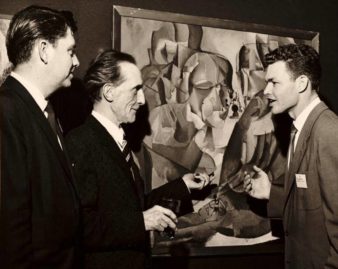
- At AFA’s 48th annual convention, held in Houston, Meyer Schapiro gives the keynote address, “The Place of Painting in Contemporary Culture,” and Marcel Duchamp gives a talk called “The Creative Act.”
- At the request of the Reynolds Metals Company, AFA begins the annual selection of a sculptor to be commissioned by Reynolds to make a piece of sculpture with aluminum. Theodore Roszak receives the first such commission. With support from Reynolds, AFA circulates exhibitions organized around the selected artists.
1958
- At the request of the State Department, AFA organizes an exhibition for the American Pavilion of the 1958 World’s Fair in Brussels—the first world’s fair of the postwar period. Selected by an appointed jury of experts and with carefully defined goals from the USIA and other government officials, Seventeen American Artists is dominated by abstract expressionists.
- Between 1958 and 1962, AFA donates 20 paintings to American museums through the Museum Purchase Fund, established by Gloria Vanderbilt in 1953 to help artists achieve greater recognition.
1959
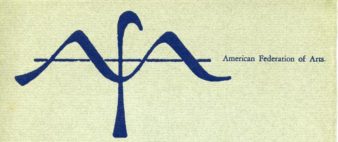
- With 2,000 individual and institutional members and a full-time staff of 17 employees, AFA is firmly entrenched in the life of the American art world, with more than half of the colleges and universities that are AFA members dependent on them for more than 50 percent of their exhibitions, or “road shows,” as they are often called.
- Among the Golden Anniversary Exhibitions organized in honor of AFA’s 50th anniversary is Form Givers at Mid-Century. Sponsored by Time magazine, the exhibition posits that American architecture is now in the vanguard.
- With a grant of $253,000 from the Ford Foundation, AFA initiates the Ford Foundation Retrospectives, a series of 19 shows on the work of leading American artists from different regions of the country. Artists include Milton Avery, José de Creeft, Lee Gatch, and Abraham Rattner, among others. Exhibitions tour the country from 1959 to 1963.
- At the request of a philanthropist and art collector who wishes to remain anonymous, AFA establishes the Museum Donor Program, a program in which a group of art museums or college galleries selected by AFA are authorized to choose up to $5,000 worth of works of art by younger, less well-known American artists. The purchases are paid for by the donor through the AFA. The program continues until 1967, when the donor dies in an airline accident. At that point, 35 institutions and 267 artists had benefited from the donor’s generosity.
- Among the AFA exhibitions seen at 480 venues are Ten Modern Masters of American Art: 30 Works Selected from The Joseph H. Hirshhorn Collection and A Rationale for Modern Art.
- AFA’s Art and the Found Object, which combines the work of first-generation readymade artists Marcel Duchamp and Joseph Cornell with second-generation neo-dadaist Robert Rauschenberg, is the first major exhibition featuring this type of artwork. Rauschenberg meets Duchamp for the first time while the two are installing their works for the exhibition. Duchamp recreates his first readymade sculpture, Bottle Rack, for the show and sells it to Rauschenberg for just 3 dollars after the exhibition closes. Art and the Found Object will serve as a historical precedent for the AFA’s 1994 exhibition Neo-Dada: Redefining Art, 1958–62.
1960
- Of the 573 AFA showings, 290 are held in museums and galleries; 45 in university museums; 204 in universities, colleges, high schools, and libraries; and 34 in art clubs, craft guilds, and business organizations.
- In honor of AFA’s 50th anniversary, AFA organizes American Art, 1910 to 1960, an exhibition of 50 paintings and sculptures by leading artists of the past 50 years from the collection of AFA President Roy R. Neuberger and his wife Marie. Honorary sponsors of the event are Governor and Mrs. Rockefeller, Mayor and Mrs. Robert F. Wagner, and Robert Moses.
- AFA organizes and circulates the first Jacob Lawrence retrospective.
1961
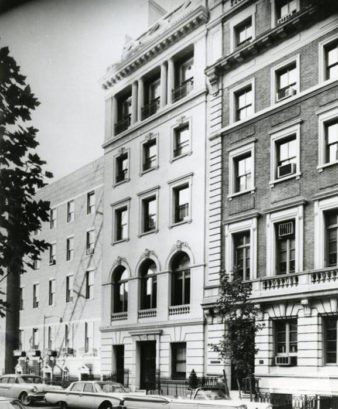
- With a leadership gift from the J.M. Kaplan Fund sparking a successful funding campaign, AFA purchases a townhouse at 41 East 65th Street for its new headquarters.
- AFA receives funding to organize a series of educational exhibitions for the newly established New York State Council on the Arts. In the first year of the program, 7 exhibitions are developed, and more than 12 more are assembled in subsequent years. Exhibitions are circulated to cultural institutions throughout New York State for rental fees of $50 or less.
- AFA membership numbers 465 institutions and 2,400 individuals. There are 574 exhibition presentations in 42 states, the District of Columbia, and 4 Canadian provinces.
1962
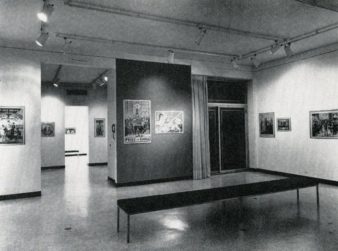
- AFA opens an art gallery on the first floor of its new headquarters. The gallery is used as a launching pad for AFA circulating exhibitions and for 1-time showings of special exhibitions, such as Madison Avenue, 1880.
- AFA’s new headquarters are graced with an outdoor, all-season garden designed and executed by George Nakashima. The garden is a gift from Jane Grasselli.
At AFA’s annual meeting, Arthur Schlesinger, Jr., gives a talk titled “Government and the Arts.”
1963
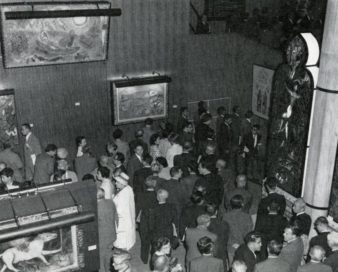
- AFA’s convention is held in Fort Worth 54 years after its first exhibition appeared in that city’s public library. The role of government is the theme, and a statement sent by President Kennedy includes the following: “I am glad to learn that the American Federation of Arts is shaping its Biennial conference around the subject of government in the arts today . . . I know your discussions will throw light upon this large subject. With best wishes for a successful conference.”
- AFA inaugurates the Artists-in-Residence Program. Funded by the Ford Foundation Program for Visual Arts, the program offers artists 1-month residencies in small and mid-sized museums across the country. Between 1963 and 1966, 81 artists participate in the program, among them, Will Barnet, Ralston Crawford, Ad Reinhardt, and Richard Stankiewicz. A similar program—the Rent-an-Artist Program—is launched in 1971 with support from the National Endowment for the Arts.
- AFA publishes the AFA Quarterly as a tool for communicating with members.
- AFA’s catalogue of exhibitions for the 1963–64 season lists 89 shows, including The Arts of Africa; New Forms in Concrete; One Hundred Years of American Realism; Fifteen Years of Award-Winning Prints; Tuscany in the 19th Century; and Marc Chagall Exhibition—Japan.
1964
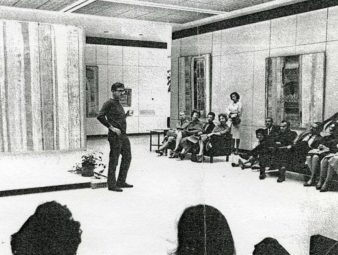
- At the request of the Albert A. List Foundation, AFA administers the List Art Poster Program, through which artists are commissioned to design and execute original posters for cultural events around the country. Among the artists in the program are Joseph Albers, Romare Bearden, Lee Bontecou, Alexander Calder, Marc Chagall, Jim Dine, Jasper Johns, Ellsworth Kelly, Georgia O’Keeffe, Robert Motherwell, Claes Oldenburg, and Frank Stella. Nonprofit institutions are invited to apply for consideration. The posters, signed and numbered by the artists, are available for sale through the AFA in limited editions of 100 each.
- With support from Clairol, AFA organizes Mother and Child in Modern Art for the Fine Arts pavilion at the New York World’s Fair.
- AFA organizes its first travel program for members—A Tour Through Byzantium.
- Among AFA’s offering are The Spirit of New Berlin in Painting and Sculpture, sponsored by the city of Berlin and selected by the German Arts Council, which includes work by 15 artists living in postwar Berlin, many of them exhibiting in the U.S. for the first time; Prints by Great Masters, selected from The Metropolitan Museum of Art by A. Hyatt Mayor; Vases from the Etruscan Cemetery at Cerveteri, lent by the C.M. Lerici Foundation in Milan and circulated with the cooperation of the Italian Cultural Institute; and The Photographer and the City, with works by Atget, Alvin Langdon Coburn, Ben Shahn, and Alfred Stieglitz, among others lent by the Library of Congress.
- A 3-year grant from the Old Dominion Foundation enables AFA to prepare several low-cost exhibitions for circulation to small communities.
1965
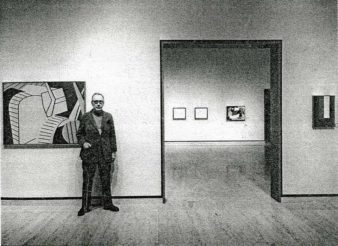
- At the suggestion of AFA Trustee Alice M. Kaplan and with funding from the J.M. Kaplan Foundation, AFA produces a pilot film on visual education. The following year, a major Ford Foundation grant enables development of The Curriculum in Visual Education, a series of films with instructional materials designed to heighten aesthetic awareness in children. The series is circulated commercially as The Art of Seeing.
- In conjunction with its biennial convention held in Boston, AFA publishes The Cultural Resources of Boston.
- AFA assumes administration of the Sara Roby Collection (given in 1984 to the National Museum of American Art, Smithsonian Institution), making it available to university art galleries and small museums. Exhibitions organized from the collection include The Collection of the Sara Roby Foundation (1966); Realism and Surrealism in American Art, from the Sara Roby Foundation Collection (1971); Americans: Individualists at Work, from the Sara Roby Foundation Collection (1972); and Selections from the Sara Roby Foundation Collection (1978).
- AFA publishes the papers delivered at its 52nd biennial convention in Boston under the title The Critic and the Visual Arts. Included are papers by Rudolf Arnheim, Jacques Barzun, Max Kozloff, Hilton Kramer, and others.
AFA organizes 19th and 20th Century European Drawings, the first in a series devoted to drawings and funded by the Samuel H. Kress Foundation. This is followed by 17th and 18th Century European Drawings (1966) and 15th and 16th Century European Drawings (1967).
1966
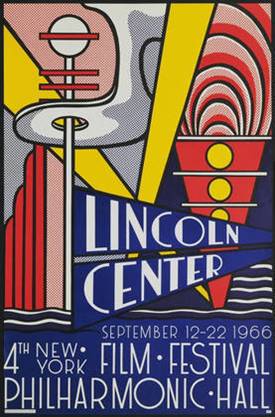
- AFA circulates Ten Negro Artists from the United States, an exhibition originally created for the First World Festival of Negro Arts in Dakar, Senegal.
- AFA collaborates with the Guggenheim Foundation to circulate John Simon Guggenheim Memorial Foundation Photography Awards, an exhibition of the work of the foundation’s photography fellows, among them, Ansel Adams, Bruce Davidson, Robert Frank, Dorothea Lange, Eliot Porter, and Edward Weston.
- AFA circulates Art for Everyman, the first exhibition of works published by Multiples, Inc., the gallery opened by Marian Goodman in 1965. By focusing exclusively on multiples, the gallery introduces a new concept of selling art to the growing New York gallery scene. Among the artists in the exhibition are Josef Albers, Jim Dine, Philip Guston, Ellsworth Kelly, Roy Lichtenstein, Robert Motherwell, Barnett Newman, Claes Oldenburg, Niki de Saint-Phalle, Man Ray, and Jean Tinguely.
- Organized 2 years after the Museum of Modern Art’s Responsive Eye exhibition introduces op art to the public, AFA’s Op Art and Its Antecedents situates this 1960s movement within a larger art-historical context. With sculptor George Rickey serving as a consultant, the works of Josef and Anni Albers, Richard Anuszkiewicz, Bridget Riley, and Victor Vasarely are juxtaposed with geometric mosaics, textiles, pottery, and other works from the ancient near east, Moorish Spain, 19th-century India, and 20th-century Aboriginal Australia.
- AFA circulates the first major exhibition of graphic works by pop and op artists Jim Dine, Ellsworth Kelly, Roy Lichtenstein, Bridget Riley, James Rosenquist, Victor Vasarely, and Andy Warhol, among others. Pop and Op provides a context to these 1960s movements at the height of their popularity. Max Kozloff contributes to the exhibition catalogue. The exhibition’s sponsorship by Philip Morris, Inc., represents an early example of the rising trend of corporate sponsorship of art exhibitions.
- AFA organizes Late Works by Marsden Hartley, the first major traveling exhibition to focus on the artist’s works from the last 10 years of his life.
- AFA’s The Australian Painters, 1964–1966: Contemporary Australian Painting from the Mertz Collection provides U.S. audiences with the first comprehensive examination of the contemporary painting of Australia.
1967
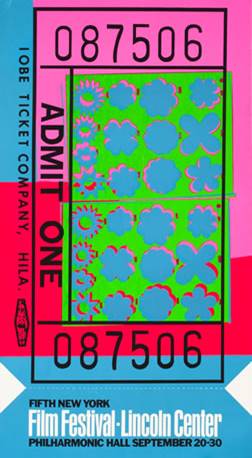
- In collaboration with Queens College and with support from AFA President Roy R. Neuberger, AFA offers the Workshop in Art Criticism. The course is initially taught by Max Kozloff.
- AFA organizes American Masters—Art Students League in celebration of the tenth anniversary of the Art Students League. Traveling to more than 7 venues, American Masters features the work of Thomas Hart Benton, William Merritt Chase, Stuart Davis, Thomas Eakins, Philip Guston, Marsden Hartley, Robert Henri, Hans Hofmann, Winslow Homer, George Inness, George Luks, and John Marin, among others. The show offers exposure to important American artists just as a new generation of art historians is becoming increasingly interested in developing a history of American art.
- With a grant from the Old Dominion Foundation, AFA organizes The American Poster, a large-scale exhibition documenting the history of visual culture and poster design in the U.S. from the late 1800s to the mid-1960s. Included are works by Maxfield Parrish, Norman Rockwell, Ben Shahn, and Wes Wilson, among others. The exhibition travels to 14 venues across the U.S.
AFA organizes Rejective Art, the first major traveling exhibition on minimalism. Curated by Lucy Lippard, the exhibition includes the work of Carl Andre, Mel Bochner, Donald Judd, Sol LeWitt, Robert Mangold, Brice Marden, Agnes Martin, Robert Morris, Robert Ryman, and Tony Smith, among others.
1968
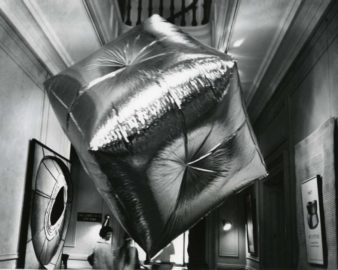
- AFA organizes Soft and Apparently Soft Sculpture, one of the first exhibitions on post-minimalist art. Curated by Lucy Lippard, the exhibition features the work of Louise Bourgeois, Hans Haacke, Eva Hesse, Yayoi Kusama, Robert Morris, Bruce Nauman, Claes Oldenburg, and Richard Serra, among others.
1969
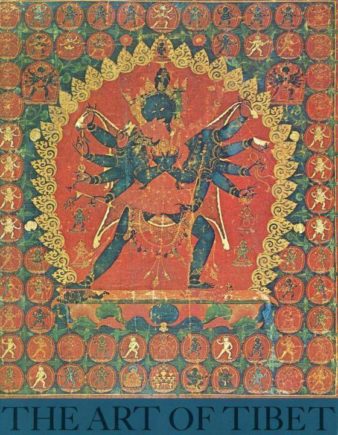
- With funding from the Avalon Foundation and in cooperation with the National Gallery of Art, AFA establishes Circulating Films on Art, one of the most comprehensive resources for films on art in the U.S. AFA is the first organization of its kind to circulate such films for rent.
Among AFA’s offerings are Contemporary Art in Yugoslavia; The Square in Painting, selected by op art painter Richard Anuszkiewicz; and The Art of Tibet.
1970
- During the previous 10 years alone, AFA has organized 64 exhibitions and sent 24 exhibitions abroad.
- AFA initiates its Annual Design Competition, honoring excellence in the design of publications and printed materials produced for the art museum community. The goal is to reward distinction in the field and promote higher standards through competition.
- The Social Rehabilitation Service of the Department of Health, Education, and Welfare funds the Handex Appalachian Project, an AFA initiative designed to encourage and preserve American handicrafts while creating jobs and alleviating economic depression. AFA administers the program until 1973, at which point the design research and all the designs and prototypes developed by Handex for furniture, textiles, ceramics, and hand-blown glass are transferred to Berea College in Kentucky.
1971
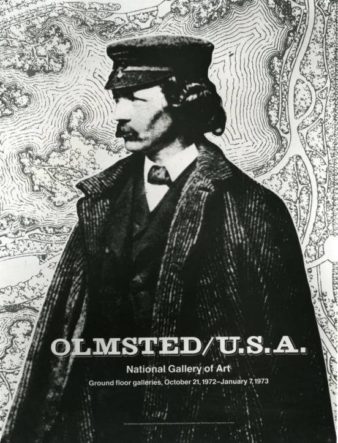
- AFA begins circulating 200 films from the Whitney’s New American Filmmakers series.
- AFA inaugurates the Rent-an-Artist Program (renamed the Visitor Artist Program a year later), which places artists in residency at museums around the country in order to offer museum visitors a window into the creative process.
- AFA circulates 39 exhibitions, with 188 showings in 43 states.
- In conjunction with the Olmsted Sesquicentennial Committee, AFA organizes two major exhibitions honoring the work of Frederick Law Olmsted. Frederick Law Olmsted / U.S.A. opens at the National Gallery of Art in Washington, D.C., and travels to the Museum of Science and Industry in Chicago; and an exhibition on Olmsted’s achievements in New York opens at the Whitney Museum of American Art.
- AFA collaborates with the Ford Foundation to publish The Future of the City, a study by architects about the issues affecting major cities.
1972
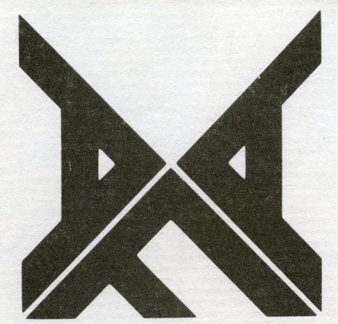
- AFA’s The Realist Revival is one of the first major exhibitions on the innovative work of a growing number of artists focusing on contemporary realism during the 1960s and 70s. Included is work by artists such as Jack Beal, Robert Bechtle, Richard Estes, Janet Fish, Philip Pearlstein, and Sylvia Sleigh. Among the AFA offerings are Bonnard: Drawings from 1893–1946, the first major exhibition of this artist’s drawings in the U.S.; and Drawn from Nature / Drawn from Life, which explores the plein-air technique of Frederick Church, Winslow Homer, and Daniel Huntington and highlights the growing appreciation of works on paper during the 19th century.
- AFA circulates For Judy Raffael—Four Quilts by Seventy Women. Raffael began her quilt project in 1970 by sending 13-inch muslin squares to women across the country. During her “sewins,” collaborators spend 3 days sewing their squares together. Like Judy Chicago’s The Dinner Party (1974–79) or Miriam Shapiro’s femmageworks dating from 1971, the quilts represent the collective labor of a group of women, using the materials and techniques traditionally considered “women’s work.”
- AFA circulates a large retrospective of the work of Bauhaus architect and designer Marcel Breuer. Organized by The Metropolitan Museum of Art, Marcel Breuer at The Metropolitan Museum of Art—the museum’s first 1-man architectural show—travels nationally, as well as to Paris and Berlin.
1973
- In cooperation with Films Incorporated, AFA circulates Films on Art from the collection of the Arts Council of Great Britain.
- AFA organizes Haitian Painting: The Naive Tradition, which presents a snapshot of contemporary painting in Haiti. Curated by Pierre Apraxine, the exhibition travels to more than 10 venues across North America, as well as to the Musée d’Art Haitien in Port-au-Prince, Haiti.
1974
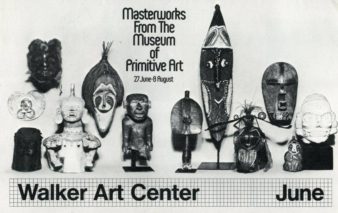
- AFA organizes Masterworks from the Museum of Primitive Art, which travels to more than 10 venues, including the Museum of Fine Arts, Houston, the Art Institute of Chicago, and the Walker Art Center in Minneapolis. This groundbreaking exhibition of more than 150 works emphasizes the specific cultural significance and utilitarian uses of the tribal works on display and also critiques the negative connotations behind the term primitive as it was first used in 1938 by art historian Robert Goldwater. In 1977, this collection forms the newly opened Rockefeller Wing of The Metropolitan Museum of Art.
- Organized by AFA and the Center for Inter-American Relations and with support from the National Endowment for the Arts, El Dorado: The Gold of Ancient Colombia, drawn from the collection of the Museo del Oro in Bogota, Colombia, travels for 2 years to 10 venues across the U.S., including the Museum of Fine Arts, Boston, and the Dallas Museum of Fine Arts.
1976
- AFA organizes the first curatorially selected international traveling film exhibition, A History of the American Avant-Garde Cinema, establishing film’s place in American art museums. Media arts exhibitions become integral to the AFA’s offerings.
- AFA forms a Film Advisory Committee.
- With support from the National Endowments for the Arts and the Humanities, AFA forms an International Exhibitions Committee to heighten the visibility of American art abroad. Among the shows organized with the committee’s help are the Richard Diebenkorn/Harry Callahan selection for the 1978 Venice Biennale and, in 1980, the first Mary Cassatt exhibition in Japan.
- AFA releases the New American Filmmakers distribution catalogue of independent films. Produced in cooperation with the Whitney Museum, the catalogue is funded by the New York State Council on the Arts.
- AFA’s exhibition The Last Empire: Victorian Photography of British India, which opens at the Asia House Gallery, presents a panoramic view of India recorded by British photographers between 1850 and 1905. The catalogue includes an introduction by Earl Mountbatten, the last British Viceroy in India.
- AFA collaborates with the Institute of the National Museums of Zaire and the African-American Institute to circulate Art from Zaire: 100 Masterworks from the National Collection.
1977
- AFA publishes Films on Art: A Source Book, the second edition of the landmark 1952 volume Films on Art.
- In association with the Newark Museum, AFA circulates Survival: Life and Art of the Alaskan Eskimo, an exhibition of more than 200 objects dating from prehistoric times to the contemporary period that documents the Eskimo culture and methods of adaptability in an increasingly industrialized Alaska.
1978
- AFA organizes Objects of Bright Pride: Northwest Coast Indian Art from the American Museum of Natural History, an exhibition so popular that it is reassembled for a second national tour in 1988.
- On the occasion of the rediscovery and rescue of Arshile Gorky’s 1936 aviation murals at the Newark Airport, AFA circulates Murals without Walls: Arshile Gorky’s Aviation Murals Rediscovered. Gorky painted the 10 mural panels—called Aviation: Evolution of Forms under Aerodynamic Limitations—for the Newark Airport Administration Building, under the auspices of the WPA’s Public Works of Art Project, from 1935 to 1937. The murals had been covered over in the 1940s when the airport was taken over by the federal government’s War Department.
1979
- With the proceeds from the AFA’s 70th anniversary honoring Alice M. Kaplan and Roy R. Neuberger, AFA launches a major traveling exhibition program jointly organized with The Metropolitan Museum of Art and drawn from The Metropolitan’s collections. AFA’s exhibition Vuillard: Drawings, 1885–1930 travels to more than 14 venues across the U.S. and Canada. Never exhibited during Vuillard’s lifetime, the 60 rarely seen works are drawn from the collection of Alfred Ayrton by William S. Lieberman.
- AFA circulates Selections from the Collection of the Alex Hillman Family Foundation, 30 works by European modernists such as Braque, Bonnard, Cézanne, Degas, André Derain, Raoul Dufy, Manet, Matisse, and Picasso.
1980
- Among AFA’s offerings are The Gold of Ancient Colombia; The Art Fabric: Mainstream; The Art of Mary Cassatt (organized for circulation in Japan); African Furniture and Household Objects, a groundbreaking exhibition in African art connoisseurship; and The Painter and the Printer: Robert Motherwell’s Graphics, the first major exhibition of Motherwell’s graphic works. The Painter and Printer travels to more than 15 venues across the U.S. and Canada, including The Museum of Modern Art, the Los Angeles County Museum of Art, the Phillips Collection, and the Nelson-Atkins Museum.
- AFA begins publication of a new newsletter 3 times a year. The Newsletter features information on AFA programs and articles of general interest to the museum going public.
- AFA’s individual and institutional membership numbers 1,600—representing 48 states, Puerto Rico, the U.S. Virgin Islands, and 15 foreign countries.
1982
- AFA organizes Frank Stella: Prints, 1967–82, the first retrospective of Stella’s graphic art. The exhibition of 83 works travels to 13 venues, including the Whitney Museum of American Art, the Cleveland Art Museum, the Nelson-Atkins Museum, and the Columbus Museum of Art.
- AFA and The Metropolitan Museum of Art organize The Art of Chivalry: European Arms and Armor from The Metropolitan Museum of Art.
1983
- Organized by AFA and the Japan Society in conjunction with the Peabody Museum, Kanban: Shop Signs of Japan is the first U.S. exhibition of the traditional Japanese art of sign-making. AFA also organizes Mimbres Painted Pottery: Ancient Art of the American Southwest, the first comprehensive exhibition of Mimbres painted pottery; and Imogen Cunningham: a Centennial Exhibition, which examines the full breadth of the artist’s career as a major contributor to the history of photography.
- AFA begins organizing traveling video exhibitions. Among the first are American Documentary Video: Subject to Change; New Video: Japan; and Revisiting Romance: New Feminist Video.
1984
- With support from Mobil, the National Endowment for the Arts, the National Endowment for the Humanities, an indemnity from the Federal Council on the Arts and the Humanities, and Air New Zealand, AFA collaborates with the government of New Zealand and the Maori people to organize Te Maori: Maori Art from New Zealand Collections, the first major presentation of Maori art in the U.S. Comprised of 174 sculptures and carvings shown for the first time outside of New Zealand, the exhibition opens with an official dawn ceremony at The Metropolitan Museum of Art on September 10, with 100 Maori people participating. In New York, more than 200,000 visit the exhibition. Other venues include the Saint Louis Art Museum, the Fine Arts Museums of San Francisco, and the Field Museum. A milestone in the Maori cultural renaissance, the exhibition continues to 3 venues in New Zealand.
- Mark Rothko: Works on Paper, organized by the AFA with the Mark Rothko Foundation, is the first major exhibition of this artist’s work in various paper media. Included is a group of newly discovered colorful paintings on paper dating to 1968 and 69 that differ dramatically from the dark paintings typical of his later years. The exhibition travels to 8 venues, including the National Gallery of Art, the Solomon R. Guggenheim Museum, and the Saint Louis Art Museum.
1985
- AFA develops the AIRGO Art program to provide member museums with safe transit for fine art and historical objects at discounted rates. Three years later, VANGO Art is developed to provide safe ground transportation.
- In conjunction with the American Folk Art Museum in New York, AFA organizes American Folk Art: Expressions of a New Spirit. Drawn from the museum’s collection, the exhibition includes approximately 140 works dating from the 18th to the 20th centuries. After completing an 8-venue tour, the exhibition inaugurates the American Folk Art Museum’s new permanent headquarters in New York on West 53rd Street.
- AFA circulates Hidden Heritage: Afro-American Art, 1800–1950, curated by David Driskell. The exhibition is an important follow up to Driskell’s groundbreaking Two Centuries of African-American Art, presented in 1976 at the Los Angeles County Museum of Art.
1987
- AFA’s merger with the Art Museum Association of America (AMAA) brings together the 2 oldest nonprofit art museum organizations in America, creating a larger national organization that can offer a comprehensive set of services without duplication. Retaining the name American Federation of Arts, the new organization maintains offices in both New York and San Francisco. Former AMAA Director Myrna Smoot becomes director.
- AFA takes on the administration of the Museum Management Institute, a 4-week residential museum leadership course held each summer in Berkeley, California.
- Among the AFA’s offerings are Before Hollywood: Turn-of-the-Century Film from American Archives, a watershed event in the development of film scholarship; the first major retrospective of the work of African-American artist Robert Colescott (Robert Colescott: A Retrospective); and Ellsworth Kelly: A Print Retrospective, a stunning record of the graphic work of a major 20th-century artist.
1988
- With the assistance of the Minister of Culture and Communication of the government of France, AFA circulates Lartigue: Panoramas of the Twenties, the first exhibition of the artist’s panoramic work. Organized by the Association of the Friends of Jacques Henri Lartigue, Lartigue premiers at the Grand Palais in Paris and travels to the Museum of Modern Art in New York before touring to 11 other U.S. venues.
- AFA circulates the landmark exhibition Harlem Renaissance: Art of the Black America, organized by the Studio Museum in Harlem.
1989
- On its 80th anniversary, AFA receives a citation from Governor Mario M. Cuomo in recognition of its “unique and continuing service to the cultural well-being of the people of our state”; a proclamation from NYC Mayor Edward I. Koch, proclaiming October 25, 1989 (the day the anniversary is celebrated), “American Federation of Arts Day”; and a donation from Roy Lichtenstein of a limited-edition screen-print poster, Reflections: Art (1988).
- AFA launches In Our Time: The World as Seen by Magnum Photographers, the first comprehensive survey of the work of the renowned photography collective Magnum Photos, Inc. Traveling to 4 continents, the exhibition is ultimately seen in 36 cities in 17 countries.
- With a grant from the Lila Wallace–Reader’s Digest Fund, AFA launches ART ACCESS, a fee-subsidy program making exhibitions of American art more affordable for museums of all sizes.
- AFA begins a 4-year tour of I Dream a World: Portraits of Black Women Who Changed America, an exhibition of 75 photographs by Pulitzer prize-winning artist Brian Lanker. Organized by the Corcoran Gallery of Art and with support from the US West Foundation, the exhibition travels to more than 15 venues across the country.
1992
- AFA organizes the first comprehensive exhibition of Italian 19th-century painting in the U.S. with Ottocento: Romanticism and Revolution in 19th-Century Italian Painting; as well as the first examination of the full range of Stuart Davis’s activity as a draftsman, with The Drawings of Stuart Davis: The Amazing Continuity.
1993
- Recognizing the importance of educational and interpretive materials, AFA hires its first curator of education.
- AFA initiates TAP (Technical Assistance Program), a fee-based program providing customized professional services for planning and implementing 1-site or traveling exhibitions.
- AFA transfers its collection of prize-winning American and European films and videotapes to the Museum of Modern Art’s Circulating Film and Video program. In cooperation with the National Endowment for the Arts and Oxford University Press, AFA publishes Museum Design: Planning and Building for Art.
- AFA circulates 20 fine arts exhibitions and 13 media arts exhibitions to a total of 119 venues. Exhibitions include A Shadow Born of Earth: New Photography in Mexico; Facing the Past: Nineteenth-Century Portraits from the Collection of the Pennsylvania Academy of the Fine Arts; and Alone in a Crowd: Prints of the 1930s 40s by African-American Artists.
- AFA donates the bulk of its records to the Archives of American Art, which, with funding from the Luce Foundation, arranges and describes the collection.
1994
- The AFA exhibition Neo-Dada: Re-defining Art, 1958–62 is the first to focus on the neo-dada phenomenon in the U.S. and Europe since the AFA’s 1960 exhibition Art and the Found Object. AFA circulates China’s New Art, Post-1989, the first major survey of the Chinese avant-garde to take place outside of mainland China; and Richard Estes: The Complete Prints, an exhibition of the artist’s iconic photorealist works on paper.
- ART ACCESS II expands on the earlier ART ACCESS program with the help of a generous grant from the Lila Wallace–Reader’s Digest Fund. The program enables the creation and circulation of 12 traveling exhibitions, along with the development of site-specific outreach strategies in collaboration with the participating museums.
1995
- With support from the Joe and Emily Lowe Foundation, AFA holds its first annual Directors Forum, a 3-day conference for art museum directors.
AFA organizes An Eccentric Orbit: Video Art in Australia. Supported by the Australian Film Commission, this major exhibition of Australian electronic art is first screened at the Museum of Modern Art.
1997
- The AFA and the Metropolitan Museum of Art organize Still Life—The Object in American Art, 1915–1995: Selections from The Metropolitan Museum of Art, continuing the goals of A Century of American Still Life Painting, 1813–1913, which 30 years earlier the AFA had presented in collaboration with The Metropolitan. Additional offerings include Elliott Erwitt: To the Dogs, an exhibition of 5 decades of Erwitt’s photography.
1999
- AFA exhibitions Maxfield Parrish: 1870–1966 and Rembrandt to Gainsborough: Masterpieces from England’s Dulwich Picture Gallery attract record numbers of visitors at the Memorial Art Gallery at the University of Rochester and the Speed Art Museum, Louisville, respectively.
AFA offers its support to the Brooklyn Museum of Art in its presentation of Sensation: Young British Artists from the Saatchi Collection when New York Mayor Rudolph W. Giuliani threatens to withhold city funding to the museum if the exhibition opens.
2000
- The AFA exhibition catalogue Shamans, Gods, and Mythic Beasts: Colombian Gold and Ceramics in Antiquity is recognized by the American Institute of Graphic Arts in the “AIGA 50 Books/50 Covers of 1998” competition for excellence in book design and production.
- AFA begins a 3- year tour of Wolfgang Laib: A Retrospective, the first major survey of the artist’s work in the United States.
2001
- With Philippe de Montebello as the keynote speaker, AFA holds its first Curators Forum for art museum curators.
- AFA begins a 3-year tour of the blockbuster exhibition Eternal Egypt: Masterworks of Ancient Art from The British Museum, the first comprehensive exhibition to take an art historical approach to pharaonic art.
- AFA and the Musée d’Orsay organize Manet: The Still-Life Paintings, the first major exhibition of Manet’s work devoted to this genre. The exhibition is presented at the Walters Art Gallery and the Musée d’Orsay.
2003
- AFA launches ArtTalks, a public lecture series featuring prominent figures in the art community. The first speaker is Shirin Neshat.
- With The Drawings of François Boucher, AFA organizes the first comprehensive international study of Boucher’s drawings.
Degas and the Dance, an exhibition organized by the AFA with the Detroit Institute of Arts and the Philadelphia Museum of Art, is the first exhibition to concentrate on Degas’ dance-related work. The exhibition is the basis of a documentary of the same name broadcast on PBS as part of their Great Performances series.
2008
- AFA adds a podcast program, ArtPods, to its web site. The first ArtPod, “Larry Poons in Conversation with Karen Wilkin”—created in conjunction with the AFA exhibition Color as Field: American Painting, 1950–1975—receives a MUSE award for outstanding achievement in museum media from the American Association of Museums.
- AFA’s Roman Art from the Louvre shatters attendance records at both the Indianapolis Museum of Art and the Oklahoma City Museum of Art.
2009
- The director of the Everson Museum of Art, Steven Kern, refers to the presentation of AFA’s Turner to Cézanne: Masterpieces from the Davies Collection, National Museum Wales as a “triumph for both the Everson and the Syracuse community as a whole.” At the Columbia Museum of Art, Executive Director Karen Brosius says of the exhibition that it “brought unprecedented attention and stature to South Carolina.”